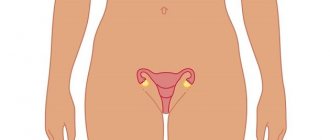Every month a woman experiences physiological changes occurring in her body. The menstrual cycle, which indicates the normal functioning of the reproductive system, should be regular. The slightest deviations from the norm and disturbances in the functioning of the reproductive system may indicate pathological processes that have arisen in the body. Therefore, it is so important to pay attention to the nature and course of the cycle in order to identify problems in time and begin treatment. One of the reasons for concern may be scanty periods, the cause of which, at first glance, may be harmless if we are not talking about pregnancy. And if previously such manifestations were not considered the norm of the cycle, then you will need to consult a specialist who will determine their nature and prescribe a course of treatment.
Scanty periods can be a normal manifestation of the functioning of the body and the reproductive system in particular when it comes to young girls. However, if similar symptoms occur in women at an older age, this may indicate health problems that are best diagnosed in a timely manner.
Why are my periods scanty?
The most common cause of concern for girls and the reason for contacting a gynecologist is hypomenorrhea. This is the name of one of the deviations from the norm, which manifests itself in the form of scanty periods, when there is little blood released during menstruation and the volume of blood loss barely reaches 50 ml, and the duration is reduced to 2 or 3 days. The norm is considered to be from 50 to 150 ml of blood over 5-7 days. It is worth noting that visiting a doctor is inevitable. In most cases, it is impossible to get rid of the pathology without medications.
Causes of dark brown periods
This question is easy to answer - the blood released may include particles of clotting blood. Dark brown menstruation is considered safe and typical if it occurs in this form at the beginning and at the end of menstruation. This phenomenon can also be accompanied by taking hormonal drugs, for example, oral contraceptives.
But sometimes a woman’s brown discharge accompanies the entire period of menstruation. In fact, you shouldn’t give in to anxiety and panic; you don’t need to suspect any serious abnormalities or diseases. Perhaps the woman is simply taking medications that somehow affect hormonal levels. To make sure of this, simply consult a doctor.
Only a physician can confirm for sure that dark brown discharge during menstruation is not a consequence of serious diseases, such as fibroids, cervical dysplasia, endometritis or endometriosis. If the disease still exists, you should immediately take measures as prescribed by the treating gynecologist.
Causes of hypomenorrhea: normal or not?
In order to confidently state the reasons for the development of hypomenorrhea in a particular case, the female body must be carefully examined. Every gynecologist knows that there is a list of non-dangerous situations that should not instill fear in girls and women. These include the following points:
- Teenage years. When a girl is at the age of puberty from 12 to 16 years, in the first menstruation there is little blood, the discharge is unstable and scanty. The reason is that the hormonal background of a teenage girl has not yet had time to fully stabilize. A year or a year and a half after the start of active work of the ovaries, the formation of a cycle will occur. Girls' periods will return to normal, and the amount of discharge will increase.
- Birth of a child. The absence of menstruation during pregnancy and little blood during menstruation during lactation for one and a half or two years should not worry a woman. A nursing mother almost always has an inconsistent cycle. The reason is prolactin, produced by a woman’s body while breastfeeding. Prolactin prevents eggs from maturing. Therefore, in the first days of menstruation there is little blood and a shortened duration. When complementary foods are introduced into the baby's diet, the baby is switched to a different diet, and he is finally weaned from the breast, the woman's cycle will quickly return to normal.
- Menopause. Over time, during the onset of menopause at the age of 45-55 years, a woman’s reproductive system fades away and its functions lose their strength. As a result, estrogen production slowly but surely slows down. Eggs stop maturing, and there is less blood during menstruation.
- Heredity. The most harmless cause of scanty periods, because hypomenorrhea is inherent in the genetic code and, therefore, is not a pathology.
- Exceptional situations when an absolutely healthy girl observes only once or twice a little blood during menstruation. A possible reason is the acclimatization period. In subsequent cycles, the rate of blood excreted should stabilize.
Having ruled out all the situations described above and not finding similar situations, you need to visit a gynecologist.
When should the first postpartum menstruation appear?
During the gestation period, the endocrine system of the expectant mother intensively produced progesterone (pregnancy hormone). After childbirth, it gradually adjusts to normal operation, causing a delay in the outflow of blood used by the body (menstruation).
The temporary cessation of menstruation after the birth of a child is explained by the restoration of hormonal balance after pregnancy.
After some time, the cycle is restored and appears according to schedule. The recovery period depends on the subjective characteristics of women. Sometimes this can take up to 3 months.
There is no need to panic when between the first cycle and the second, not 28 calendar days pass, as is usually the case, but 2 months. This is considered normal, especially if the woman in labor is breastfeeding her baby.
There is no need to be alarmed if menstruation occurs earlier than the woman expected. The factor that they will not go can be considered the lack of ovulation.
The final onset schedule should resume after the 3rd menstrual cycle. The speed of recovery of the cycle, the timing and intensity of menstruation directly depends on breastfeeding the baby.
After childbirth, the mother's endocrine system produces prolactin, also known as the milk hormone. It greatly suppresses the functioning of the ovaries, so ovulation may not occur, the release of the egg from the female ovaries is blocked, and therefore there are no periods.
If a woman in labor refuses to breastfeed, her body stops producing prolactin and after 2 months the cycle is restored one hundred percent. Often the nature of postpartum menstruation changes.
If, for example, before pregnancy they were accompanied by severe pain, then after pregnancy they do not cause discomfort at all, the cycle begins and passes less painfully. This is explained by the fact that during the birth process the curvature of the uterus is eliminated; it was this that made it difficult for blood to exit from it, causing severe pain.
Diseases of the reproductive organs that contribute to the development of hypomenorrhea
Another reason why there is little blood during menstruation is a progressive pathological process in the pelvis. Some of them:
- Endometriosis is a condition in which the lining of the uterus grows inside or outside of the uterus.
- Endometrial hyperplasia is a type of endometriosis where the mucous membrane grows in the deep muscular layers of the uterus.
- Endometritis is an acute or chronic inflammation of the uterine mucosa.
- Ovarian dysfunction is a disruption of the ovaries as a result of hormonal imbalance. Unstable hormone production and irregular menstrual cycle.
- Polycystic ovary syndrome is a condition characterized by more than one cystic formation in the ovaries.
- Polyps in the uterus are benign growths on the endometrium as a result of hormonal pathologies.
- Infectious diseases of the reproductive organs (STIs) are sexually transmitted infections. For example, viruses, fungal pathogens or bacteria.
Alternative reasons for dark periods in the video
https://youtu.be/BO9wdsvGhaw
Every girl (woman) knows that, starting from a certain age, girls begin menstruation. Alas, often many mothers, at best, told their daughters something like “You will have bleeding. This happens to everyone, it’s normal,” at the very moment when puberty began.
Unfortunately, due to lack of literacy regarding this issue, few of them even understand what it is, why this happens and what all this should look like in the body of a healthy woman? When menstruation suddenly appears brown, it is completely unclear why this is happening, can menstruation be of this color and is it necessary to urgently consult a doctor?
Menstruation is part of the menstrual process accompanied by bleeding. By nature, a woman is destined to give birth to offspring. In this regard, monthly (every 21-35 days) the body prepares for conception. Against this background, strong hormonal changes occur, and by the last stage of the menstrual cycle, the uterine cavity is lined with hormonal-sensitive tissue - the endometrium. This is how the embryo is prepared for implantation inside the uterine cavity, but if this does not happen, the tissue is destroyed and then removed from the uterus in the form of menstrual bleeding.
And again these days
Normally, heavy (about 150 ml in 3-4 days) bleeding of a rich red color. However, due to various reasons, deviations from this color (including odor) are possible. So, women are often bothered by dark brown periods. Why does this happen and should you worry if your periods are dark brown?
Reasons for the development of hypomenorrhea
There are several reasons why there is little blood during menstruation with secondary hypomenorrhea:
- Rapid weight loss as a result of strict diets or fasting, anorexia. In the latter case, the risk of complete disappearance of menstruation increases.
- Excess weight. In a woman’s adipose tissue, estrogen is also produced and an excess of hormones occurs in the body. This is why there is little blood during menstruation.
- Impaired metabolism.
- Hormonal changes in the body, such as pregnancy, breastfeeding or menopause.
- Damage to the genital organs. Provoking circumstances are curettage or abortion. Curettage (cleaning) procedures are performed to cleanse the uterine cavity of accumulated secretions.
- Stressful situations. Constant overwork of the body leads to exhaustion.
- Poor and inadequate nutrition without vegetables and fruits.
- Exhausting physical activity. There is a connection between muscle mass and menstruation. The larger and stronger the muscle corset in women, the less blood during menstruation.
- Endocrine disorders in the body.
- Infectious diseases.
- Partial removal of genital organs.
- Difficult recovery period after surgery.
- Disturbance in the development of the genital organs.
- Iron deficiency anemia, which inevitably affects the functioning of the reproductive organs and the entire body as a whole.
- Reduced protective properties of the body, weak immunity.
- Bad ecology.
- A pregnancy that a woman doesn’t even know she has. Little blood during menstruation up to 4 weeks is the norm, but from 5-6 weeks this condition signals placental abruption and spontaneous termination of pregnancy. A pregnancy test will clarify the situation.
- Incorrectly selected hormonal contraceptive pills. Independent choice of this type of contraception threatens not only scanty periods, but also hormonal imbalance and other diseases of the reproductive system. It is better to entrust this to your doctor.
In most cases, diagnosing hypomenorrhea to restore menstruation, it is enough to conduct an examination and eliminate the provoking factor.
Manifestation of pregnancy
Scanty discharge during menstruation after 40 years of age most often indicates that a woman’s body is gradually losing its main function of childbearing. A preclimactic state reduces the likelihood of pregnancy, but does not completely exclude it. The most common cases of pregnancy after 40 are due to the fact that a woman, confident of her childbearing inability, neglects contraception. Due to the fact that the menstrual cycle becomes irregular, it is difficult to track the onset of ovulation, and this increases the chance of fertilization.
If hypomenorrhea is accompanied by long delays, and after another delay you have scanty periods, you should take a pregnancy test and listen to your body: swollen mammary glands, swelling, morning sickness are obvious signs of pregnancy. It is likely that the body is still ready for procreation.
See also: A drop of blood before menstruation, what does it mean?
However, you need to be very careful, because scanty discharge can cause an ectopic pregnancy. This issue requires urgent contact with a specialist.
Symptoms of hypomenorrhea
Both primary and secondary hypomenorrhea are manifested by distinctive symptoms, namely:
- Little blood during menstruation. The nature of the discharge is spotting. However, the duration of menstruation may remain unchanged.
- In exceptional cases, very little blood has been recorded during menstruation, with a volume of a few drops.
- Menstruation is reduced in number of days. This pathology is called “oligomenorrhea”. There are known episodes when menstruation was reduced to 3 days or less.
- Changing the color of the discharge. The color of bloody discharge with hypomenorrhea is light, closer to a brown tint.
- Nosebleeds during menstruation.
- Systematic delay in the onset of menstruation and little blood in the first days of menstruation.
- Painful sensations in the lower abdomen during menstruation, since a small amount of discharge is accompanied by strong contractions of the muscles of the uterus.
- Headaches are common.
- Aching pain in the lower back and chest.
- Gastrointestinal disorder: nausea, constipation or diarrhea.
- General weakness.
- Decreased sexual desire due to falling estrogen levels.
Even if these symptoms do not accompany menstruation, the very fact of scanty periods instead of normal ones is cause for concern.
Natural Cycle Restoration Process
Factors that help quickly restore your menstrual schedule:
- Proper organization of the daily routine
- Complete, healthy rest
- Balanced diet
- Psychological calm
- No complications after childbirth
- No chronic diseases
The root cause of the phenomenon when the first periods after childbirth are scanty and prolonged is considered to be excessive production of prolactin due to:
- Benign tumor - prolactinoma, responsible for milk production
- Pathological changes in the endocrine system
All this together increases the production of milk or prolactin, which significantly suppresses the synthesis of other hormones that are important in the recovery process, in particular those that regulate menstruation.
Scanty periods: what needs to be examined?
Any deviation from the norm in the body is subject to mandatory examination and treatment. In the case of such a phenomenon as very little blood during menstruation, a woman should seek help from a gynecologist. The doctor will conduct an examination, taking into account all symptoms and complaints. If necessary, he will refer you for additional examination and laboratory tests. What exactly is done to make an accurate diagnosis:
- A thorough examination of the patient on the gynecological chair.
- Examination of the genital organs for the degree of purity and flora by taking a smear from the vagina.
- Diagnosis of the cervix and vaginal walls by colposcopy. A special colposcope device will allow you to see polyps, cysts or endometrial growths.
- Blood test for the concentration of sex hormones. To do this, you will need to collect venous blood on certain days of the menstrual cycle.
- Ultrasound examination of the condition of the pelvic organs - ovaries and uterus.
- It is necessary to exclude or confirm the presence of genitourinary infections by donating PCR smears and blood.
What to do when you need to treat light and long discharge instead of menstruation
If dangerous pathologies are identified, it is possible to perform an operation or minimally invasive intervention, which will eliminate the threat to life with minimal consequences for health. What dangerous symptoms should be taken into account when there is scanty discharge instead of menstruation? When are scanty periods and light discharge without abdominal pain dangerous? In fact, vaginal discharge with severe itching and an unpleasant odor can be called dangerous. When light discharge with clots of mucus (red, white, brown mucus, transparent patches of mucus or black, scarlet mucous discharge from the genitals) comes out of the vagina), when with light discharge scarlet blood is released from the vagina, all this can be considered dangerous symptoms. You should definitely seek help from a doctor if, in addition to the fact that scanty and light discharge does not end, an elevated or high body temperature of 37, 37.5, 38, 38.5, 39 or higher degrees appears, you should definitely seek help from a doctor. Dangerous symptoms include nagging or aching pain in the lower abdomen, pain in the pubic area and genitals, when severe cramping or throbbing pain radiates to the lower left side of the abdomen or lower right side; all this requires a mandatory visit to the doctor.
In some cases, medical assistance may not be required: scanty periods turn into full menstruation after undergoing a course of massage, spa treatment, taking multivitamins or iron supplements, reviewing the diet, and giving up bad habits. At first glance, these measures may seem trivial, but the effect they have is truly stunning. Don't believe me? Try it and see for yourself.
Similar articles
Scanty periods, which also come ahead of schedule, are a reason to consult a doctor. The fact is that such a disruption of the menstrual cycle never occurs just like that: its appearance can be caused by...
Nagging pain in the lumbar region and lower abdomen, breast swelling and increased sensitivity, bowel dysfunction in the form of diarrhea are frequent companions of menstruation. As survey results show, every second person experiences these symptoms...
Nagging pain in the lumbar region and lower abdomen, breast swelling and increased sensitivity, bowel dysfunction in the form of diarrhea are frequent companions of menstruation. As survey results show, every second person experiences these symptoms...
Sometimes a woman is upset that her periods are too scanty. In this case, the desired pregnancy does not occur. What to do: treat or wait it out? You should not put off visiting a doctor, because this may be a sign of a serious illness. An examination will show exactly what the reason is. In some cases, this problem disappears by itself as soon as the woman goes on vacation, changes her environment, and calms her nerves. But long-term treatment may be necessary for everything to improve.
- Scanty periods during pregnancy
- Scanty periods after childbirth, during lactation
- Diseases of the reproductive organs causing hypomenorrhea
- Examination and treatment for scanty periods
Treatment of hypomenorrhea without drugs
If no pathologies were found in a woman after the examination, and scanty periods continue, then gynecologists recommend:
- Improve your lifestyle: move more, eliminate bad habits, spend more time in the fresh air, give preference to active recreation and get enough sleep.
- Get your diet in order to fully saturate your body with essential nutrients. High protein content is present in meat and fish, as well as legumes. Cereals are rich in complex carbohydrates. Without fats, the female body will not be able to function properly, which is why you need to include vegetable oils in your diet. Eat more fiber in the form of fresh vegetables and fruits. Reduce the amount of fatty, fried and sweet foods. Adjust your diet.
- Eliminate diets and fasting from your life.
- It is mandatory to take a vitamin-mineral complex in courses to maintain a woman’s health.
- To restore psycho-emotional balance, take a course of sedatives. Stress in the 21st century is one of the most striking examples that provokes the development of hypomenorrhea. Not every woman is able to cope with anxiety and worries on her own. As a result, sedatives are prescribed.
- It is possible to recommend a massage to improve blood circulation and relieve tension.
Why is the first menstruation after childbirth painful?
Sometimes its appearance after the birth process is accompanied by severe pain, gynecologists explain this:
- Functional disorder of the endometrium
- Weak rejection of endometrial tissue from uterine tissue
- Oversaturation of the body with prostaglandins
- High pain threshold
The pain is localized in the lower abdomen, throughout the entire area or in the middle of it, and is wavy in nature, reminiscent of weak prenatal contractions. In some women, menstrual pain radiates to the thigh or sacrum area.
Postpartum menstruation may be accompanied by headache, dizziness, nausea or abdominal cramps.
There are many ways to reduce a woman’s physical suffering during this period; you can use them or motivate yourself to any intellectual activity. Volitional switching often helps to reduce pain, or rather to distract from it.
How to treat hypomenorrhea with medications
Diagnosed hormonal disorders in the female body are subject to drug restoration. Balance is achieved by treatment with hormone-containing drugs. The selection of medication is, naturally, based on the hormone levels in a woman’s blood. The course of treatment, as a rule, lasts no more than six months. This therapy is aimed at stabilizing the functioning of the ovaries and restoring the menstrual cycle. After some time, the volume of discharge during menstruation normalizes. Clinical pictures arise when the menstrual cycle and hormonal levels can be restored with the help of birth control pills, which will also be selected by the gynecologist.
If an infection is detected in the genitals, it is necessary to concentrate treatment on the provoking factor. The woman is prescribed modern antibiotics, antifungals or drugs with anti-inflammatory effects. When girls complain of pain during menstruation, gynecologists recommend taking antispasmodics. Often drugs such as Sapzmalgon, No-shpa, Baralgin or Papaverine are prescribed.
Important! The early stages of cancer are very similar to the symptoms of ovarian dysfunction, which are manifested by scanty periods. Therefore, delaying the examination is life-threatening.
Prevention
Ideally, menstruation should be like this:
- regular and stable;
- a certain shade;
- with slight pain;
- average duration.
However, the normal menstrual cycle lasts no less than 21 days and no longer than 35 days.
If everything is not quite so, you should not immediately think about all the above diseases, worrying and giving in to panic. Dark brown menstruation is just a signal that you should pay attention to your health and general well-being. If menstruation is regular, then a slightly changed shade is not a cause for concern. But if the cycle is constantly going astray, menstruation does not occur as planned, earlier or with a delay, and there is an unpleasant odor and dark color, you should consult a doctor. Perhaps unfavorable changes are occurring inside the woman, which can be prevented only by seeking qualified help in time.
Folk recipes to combat scanty periods
Traditional recipes can easily help you cope with the disease. Onion broth has proven itself well. The recipe is suitable for people who do not have problems with the gastrointestinal tract.
Method of preparation: take one medium-sized onion, boil it in two glasses of water, take the broth before breakfast on an empty stomach. Infusions of tansy and calendula also work effectively. Recipe: add 2 teaspoons of herb to 1 liter of water. Insist, take on an empty stomach.
What are the dangers of period brown?
A strange color of menstrual blood may indicate endocrine disorders, infectious and inflammatory processes - all these factors significantly reduce the likelihood of conception and normal pregnancy.
Against the background of severe inflammatory processes, adhesions appear, the infection begins to spread to other organs, which is fraught with the occurrence of chronic pathologies and sepsis.
Brown discharge during pregnancy may indicate placental abruption, which can lead to miscarriage. Scarlet discharge is a sign of a frozen pregnancy.
Treatment with traditional methods
Traditional medicine recommends drinking pineapple juice daily
There are several proven methods of traditional medicine in the treatment of disorders that cause scanty periods.
All these folk methods will certainly help, but still, if suddenly the symptoms remain, there is no need to neglect examination by a gynecologist. If you lead a healthy lifestyle while doing gymnastics, then everything will work out.
Walking in the fresh air combined with physical activity will help prevent the onset of the disease.
You need to spend more time in the fresh air doing physical exercise. But at the same time, do not overload the body, because strong physical activity can lead to the opposite result. Research has shown that the amount of muscle mass and the menstrual cycle are related. Muscular women almost always have irregular periods.
It is necessary to avoid stressful situations and stress, which can cause hormonal imbalances: all this affects the menstrual cycle. When experiencing emotional overload, learn to relax.
It is necessary to remember: taking homeopathic medicines together with essential oils can harm the treatment of the disease.
narmed24.ru
Treatment with folk remedies
Scanty periods, which are brown in color and continue for a long time, can be treated with various folk remedies:
Diagnostics
The most common causes of the disease can be identified using a blood test
In order to identify the causes of scanty periods and determine how dangerous it is for the female body, you need to consult a gynecologist and be examined. A woman should inform the doctor about her medical history, undergo an examination, take smears from the genital tract to detect infection, and have an ultrasound of the ovaries and uterus.
The most common causes can be determined using a blood test. Of great importance is a test done to identify the level of hormones (estrogen, progesterone, thyroid hormone, prolactin, androgens and insulin). If such a test reveals high levels of insulin and androgens, then an analysis for polycystic ovary syndrome is performed. The size of the ovaries, the thickness of the endometrium and the growth of follicles are determined using ultrasound. Ultrasound allows you to diagnose the thickness of the endometrium, the size of the ovaries, the growth of follicles, the absence of ovulation and other disorders.
Warm foot baths will help improve your cycle
No therapy is required during breastfeeding or menopause. If the problems are hormonal, then if the test results are normal, hormones are prescribed. If the cause is psychological, then it can be eliminated by maintaining a healthy lifestyle and emotional calm.
There are problems for which consultation with a doctor is simply necessary:
- if the girl is 15 years old and has not yet had her period;
- during pregnancy, any discharge is visible;
- menstruation is painful, mainly pain in the lower abdomen, which may be a signal of an ectopic pregnancy;
- profuse bleeding.
Acupressure, aromatherapy and color therapy are commonly used treatments for light periods.
Acupressure will help improve your periods: you need to massage the point in the middle of the tip of your big toe every day, which will help the uterine mucosa become stronger. You need to massage in a circular motion several times a day for five minutes.
Another treatment option is aromatherapy. When inhaling the aroma of marjoram and juniper, sex hormones are released. Foot baths will help improve your periods: the bath is filled with water at a temperature of 34°C, and you need to put your feet in it. Hot water is gradually added until the temperature rises to 43°C. Everything needs to be done slowly, without rushing, for 20 minutes. After the procedure, dry your feet and wrap them with a warm towel. In order to achieve results, these baths should be started a week before the start of menstruation.
Color therapy will help improve blood circulation, hormone secretion and strengthen the uterine mucosa. In this case, yellow is suitable. By giving preference to clothes of this color and eating yellow foods, you can overcome the disorders that cause scanty periods.
https://youtu.be/92RoFZ3Y1zA










